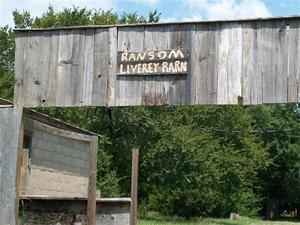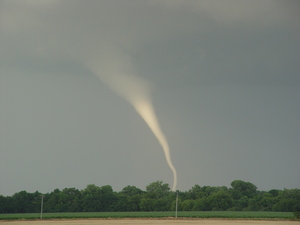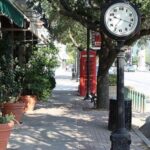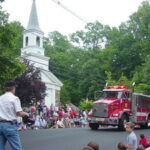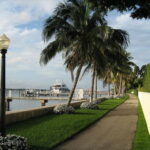Oklahoma became a state in 1907, but it’s history began long before that. In fact, many settlements and towns had sprang up and disappeared long before statehood. Tornadoes, floods, mining, the Dust Bowl and outlaws are just a few reasons many of these Oklahoma towns no longer exist. These are just a few of the most interesting (or odd) ghost towns in Oklahoma.
Ingalls – Ingalls, Oklahoma was located about four miles east of Stillwater. It was home to one of the deadliest gunfights in the Sooner State. Depending on which version of the story of this gunfight you believe, it is rumored that about seven people were killed. The Wild Bunch, led by Bill Doolin (famous for the bank robbery in Coffeyville, Kansas with the Doolin Gang) had used this town as a hideout for quite a while. The townspeople, frightened of them, allowed them access without telling law enforcement. Sheriff E.D. Nix became aware of this. He and his men decided to take the town back on September 1, 1893. The town was never to overcome it’s reputation for hiding outlaws. The post office was closed in 1907 and not much remains of this town.
Cookietown – Cookietown was located in Cotton County, just a few miles north of the Red River. Although Cookietown is not an official ghost town in Oklahoma, seeing there are a few residents (less than 10) still living there, but it is worth mentioning simply because of it’s name. The old stories says that the town got it’s name because the owner of the general store would give free cookies to children as they made their way from Texas. Although this can’t be proven, it adds to the folklore of the Sooner State.
Academy – The town of Academy in Bryan County, Oklahoma was founded in 1844. It began as a home for boys from the Choctaw Indian tribe. During the Civil War, the school was closed and became a Confederate hospital. During Academy’s years as home to the Choctaw home for boys, there was also a trading post and blacksmith shop. A church was also part of this frontier town. The school was also used as part of the Choctaw Nation’s capital. The capital was moved and it was exclusively used as a school. The school burned in 1921 and was never rebuilt. There is only a cemetery that remains in Academy today.
Bathsheba – Bathsheba was destined to be a ghost town. Located between Perry and Enid, this town was settled entirely by and for women. In fact, no males of any kind were allowed – no bulls, roosters, stallions or males of any kind were admitted to this town. It is rumored to have had a population of 33, but a dozen left the town after the first week. Suddenly, one night, the remaining women disappeared as well.
Beer City – Beer City was located in what is now the Oklahoma panhandle. In the 1880s, when Beer City was founded, it was known as “No Man’s Land” because no state or country claimed it. The town consisted of a bar and a brothel that served gunfighters, bootleggers and cattle rustlers. Beer City only survived about a decade. Around 1890, Liberal, Kansas had the railroad and the bar and brothel moved a few miles north.
Gotebo – Gotebo, Oklahoma was located in Kiowa County, Oklahoma. This was a favorite road trip of many of the Riley family, despite the fact there was nothing to do in this ghost town. Several buildings still remain and is a great place for those with active imaginations to visit. The town was named after Gotebo, a Kiowa Indian chief. It is interesting to see the people who still live around the abandoned buildings in this Oklahoma ghost town – most of which are more than willing to tell story of the glory days of Gotebo.
Hochatown – Hochatown, Oklahoma is now located at the bottom of the Broken Bow Lake. It began as a lumber camp. It then turned into the “Moonshine Capital of Oklahoma.” This was due to the fact that water from the Mountain Fork River was perfect for creating moonshine. It has been rumored that remains of Hochatown can be seen by divers.
Eddy – Eddy, Oklahoma was once in Kay County in far north central Oklahoma. This small town which had four churches was burned down in the early 1900s. Now, one can say it is “gone with the wind.” Shortly after the fire, the entire town was destroyed by a tornado and never rebuilt. There isn’t much to see other than weeds, but, if time isn’t a factor, a cemetery may be found by those who investigate further.
Cloud Chief – Cloud Chief was located in Washita County, Oklahoma. It was the first county seat. Not much is known about this ghost town – other than the jail was stolen by the residents of Cordell, a nearby town and next county seat to Washita County.
Hope – Hope was once located about 10 miles northeast of Duncan, Oklahoma. It was once believed that gold was in the area. That is what brought the Riley family to this area of Oklahoma. They lived in the area for a few months, but quickly decided that there was more money to be made in cotton and in wheat. The thought of gold is what keeps modern Rileys visiting still. It makes a great day trip for those who “hope” to strike it rich mining for gold.
Bogey Depot – Bogey Depot is one of the oldest towns in Oklahoma. It was founded in 1837. Twelve years later, the first post office for the town was opened. The railroad arrived in the 1870s about three miles away. The town was moved. Boggy Depot, the new town remains, but Bogey Depot is now part of a state park.
Cheek – Cheek, Oklahoma was once located in Carter County in south central Oklahoma. It is approximately 100 miles south of Oklahoma City. The post office was established in late 1888. The Riley family tried attempted to find oil in the area in the early 1900s, but they were unable to strike it rich. The post office closed in 1935. The town soon followed.
Emerson – Emerson was sponsored by the railroad that was making it way through Cotton County, Oklahoma. Although it only survived from 1907 to 1914, several of the Riley family were baptized at the Emerson Methodist Church. The railroad never went through Emerson which is why the settlement only lived to it’s seventh birthday.
Hockerville – Hockerville was located in Ottawa County, Oklahoma, close to the Kansas line. Lead and zinc were discovered there in 1916. Two years later, a post office was built. The post office was closed in the fall of 1963. It is surprising that the post office wasn’t closed earlier. Around 1950, due to all the mining in the area, Main Street collapsed and the residents began to move away.
Whenever in Oklahoma, keep a look out for ghost towns. There are spread out all over the state and can be found almost everywhere. Although not much is left of many of them, it is still worth the time to go hunting for them. There is no telling what can be found in and around Oklahoma ghost towns.
